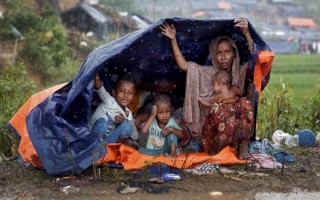Rain wreaks havoc in Rohingya camps in Bangladesh
A rain-triggered landslide killed a two-year-old Rohingya infant and injured his mother early Monday when met office forecast more rain.
Rohingyas said large areas of the camp went underwater following the downpour and fear was growing about further landsides in the one of the congested and largest refugee camps in the world.
Most of the Rohingyas are living on slope of hills, destroying trees and loosening the soil structure.
The UN Migration Agency, International Organisation for Migration on the day said that heavy monsoon rains that began on Saturday caused severe structural damage Rohingya camps.
Over 31,000 of the camps’ one million Rohingyas in Cox’s Bazar, who fled Myanmar, are still living in areas considered to be at high risk of deadly flooding and landslides.
IOM also reported some 59 incidents, including landslides, water-logging, extreme wind and lightning strikes. ‘Over the same period aid agencies reported that over 9,000 people were
affected and that this number will increase as the rains continue,’ said an IOM statement.
‘The situation in the camps is growing more desperate with every drop of rain that falls,’ IOM Emergency Coordinator in Cox’s Bazar Manuel Pereira said.
Close to one million people living on hilly, muddy terrain with no trees or shrubs left to hold the ground in place. People and their makeshift shelters are being washed away in the rains.
‘We are racing to save lives, but we urgently need more funding to maintain and expand key humanitarian support during these rains,’ he added.
Inter Sector Coordination Group, a coordinating body of the UN and international humanitarian agencies working on Rohingya crisis, said that rapid assessments pointed to 9,114 Rohingyas (2,098 families) affected by the recent rains and related incidents.
Among these, 6,004 individuals were affected by wind, 2,472 by small-scale landslides, 381 suffered from water-logging, 192 by lightning, 12 by flood and 65 by other incidents.
In addition, 855 shelters, 8 water points, 127 latrines, 1 health facility and 2 food distribution sites have been damaged or destroyed in the camps, said a statement of ISCG.
‘The refugee camps are already flooded by rain water and mudslide continues to intensify the miseries,’ said Mohibullha of Chakmarkool camp.
A Rohingya refugee, Dil Mohammad, said about 5,500 Rohingyas living in Tumbro zero line were facing immense miseries as many of their shades were inundated.
Around 2:30am Monday, a mud wall in a shelter in the Kutupalang camp collapsed, killing a two-and-half-year-old boy, Sulatan Ahmed, and injuring his mother Sayeda Khatun, Kutupalang registered camp in-charge Rezaul Karim told New Age.
Rohingyas said that the mudslide took place due to heavy rain and both victims were sleeping when the wall collapsed.
Rohingyas rushed mother and children to the Red Crescent field hospital where the duty doctor declared Sultan dead and his mother is out of danger, said Rezaul Karim.
Additional refugee, relief and repatriation commissioner in Cox’s Bazar Md Shamsudduza told New Age that several thousand Rohingyas were affected in the rain that damaged about 1,300 shelters since June 9.
‘Many Rohingyas are relocated to local schools, madrassahs and nearby shelters as their sheds collapsed during the incessant rain in the area,’ he said.
Cox’s Bazar meteorological department recorded 230mm rainfalls during in 24 hours till 6:00am on Monday.
Met office in capital said that cautionary signal 3 was in place at Cox’s Bazar and other maritime ports as monsoon was strong over North Bay and Southern monsoon has set on over Chittagong, Sylhet, Mymensingh and Dhaka division.
Met office in its special flood outlook for the South-Eastern Hilly region of Bangladesh about 2:00pm on Monday said there was chance of widespread heavy to very heavy rainfall (approximately 120 mm/day on average) in the next 24 hours.
About 7,00,000 Rohingyas crossed into Bangladesh fleeing unbridled murder, arson and rape during ‘security operations’ by Myanmar military in Rakhine, what the UN denounced as ethnic cleansing since August 25, 2017.
The influx of over 11 lakh Myanmar refugees into Bangladesh since 1978 led to indiscriminate deforestation and hill cutting.
World Health Organisation in May warned that the risks of outbreak of vector-borne epidemics and diarrheal diseases, vector-borne diseases like dengue, chikungunya, typhoid fever, hepatitis E, leptopirosis, malaria, dysentery as well as acute lower respiratory infections at congested Rohingya camps would increase during monsoon.
News Courtesy: www.newagebd.net











